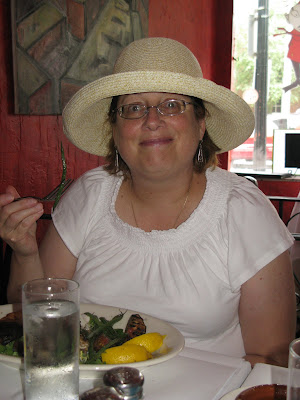There's a magical place in the center of Boston like no other - Faneuil Hall Marketplace. As alive today as it was in 1742 when our nation's fathers proclaimed it "The Cradle of Liberty," it combines the glories of Boston's past with the urban sophistication of the city today. [1]
In 1742 Peter Faneuil, Boston’s wealthiest merchant, built Faneuil Hall as a gift to the city. It was founded as a central marketplace for crops and livestock in downtown Boston. The edifice was home to merchants, fishermen, and meat and produce sellers, and provided a platform for the country's most famous orators. [1]
Inside the Faneuil hall, Sara was given a test. “Do you know what is on the top of the building?” Grasshopper!
The gilded grasshopper weather vane on top of the building was created by Deacon Shem Drowne in 1742. It is believed to be modeled after the grasshopper weather vane on the London Royal Exchange, based upon the family crest of Thomas Gresham. Gilded with gold leaf, the copper weather vane weighs eighty pounds and is four feet long [2]. From this perch, the grasshopper has witnessed the remarkable growth of the city and over 260 years of American history in the making. [1]
In 1761, a fire at Faneuil Hall damaged the grasshopper weathervane. Thomas Drowne, a blacksmith and the son of the grasshopper’s creator, repaired the weathervane and inserted a “time capsule” in its stomach. The capsule, which is engraved “Food for the Grasshopper,” includes historical newspapers, coins, and messages from mayors that have been added as the grasshopper has been periodically refurbished. [1]
Inside Faneuil Hall,
North end
Welcome to Boston’s North End … where the past meets the present…where history sometimes collides with traffic…where saints, sinners and everything in between have lived and continue to live [3].
The North End is many things to many people. It always will be. And as author David McCord has written in About Boston (1948):
“The North End! A queer composite, this slope of land, with its dockside teeth biting into the harbor and the very hide of it bristling with dark red clay and chimney pots. This is the real Boston; this is America, old and new. And it is rather comforting to remember that here in the house at the end of Sheafe Street once lived the author of some verses beginning “My country, ‘tis of thee.” [4]
What do we do at North End? Of course, we have to eat at an Italian restaurant. Maurizio’s restaurant is Baba’s favorite. The Chef of the restaurant, Maurizio Loddo hails from the Italian Island of Sardinia and brings a wealth of additional cooking experience from France, Germany and Spain. [5] Everybody seems enjoy the food very much! Again, Baba made a good choice as always.
After eating delicious food, we walked to Old North Church which sits behind the restaurant.
‘One if by land, two if by sea’
The enduring fame of the Old North began on the evening of April 18, 1775, when the church sexton, Robert Newman, climbed the steeple and held high two lanterns as a signal from Paul Revere that the British were marching to Lexington and Concord by sea and not by land. This fateful event ignited the American Revolution.[6]
References:
1. http://www.faneuilhallmarketplace.com/
2. http://en.wikipedia.org/wiki/Faneuil_Hall
3. http://www.northendboston.com/
4. http://www.northendboston.com/2011/04/welcome-to-boston%e2%80%99s-historic-north-end-neighborhood/
5. http://www.mauriziosboston.com/
6. http://www.oldnorth.com/history/index.htm













No comments:
Post a Comment